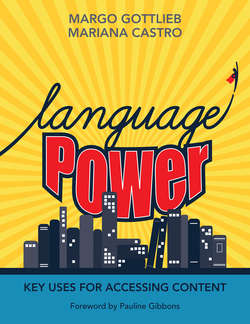Читать книгу Language Power - Margo Gottlieb - Страница 13
На сайте Литреса книга снята с продажи.
References and Further Reading
ОглавлениеAnstrom, K., DiCerbo, P., Butler, F., Katz, A., Millet, J., & Rivera, C. (2010). A review of the literature on academic English: Implications for K–12 English language learners. Arlington, VA: George Washington University Center for Equity and Excellence in Education.
Bailey, A. L., & Butler, F. A. (2007). A conceptual framework of academic English language for broad application to education. In A. L. Bailey (Ed.), The language demands of school: Putting academic language to the test (pp. 68–102). New Haven, CT: Yale University Press.
Chamot, A. U., & O’Malley, J. M. (1994). The CALLA handbook: Implementing the cognitive academic language learning approach. Boston, MA: Addison Wesley.
Cummins, J. (1981). The cross-lingual dimensions of language proficiency: Implications for bilingual education and the optimal age issue. TESOL Quarterly, 14, 175–185.
de Oliveira, L. C. (2013). Academic language in the social studies for English learners. In M. B. Arias & C. J. Faltis (Eds.), Academic language in second language learning (pp. 149–170). Charlotte, NC: Information Age Publishing.
de Oliveira, L. C. (Ed.). (2014/2015). The Common Core State Standards and English language learners. Alexandria, VA: TESOL Press.
de Oliveria, L. C. (Ed.). (2016). Common Core State Standards for literacy in history/social studies, science, and technical subjects for English language learners. Alexandria, VA: TESOL Press.
Echevarria, J., Vogt, M. E., & Short, D. J. (2017). Making content comprehensible for English learners: The SIOP model (5th ed.). Boston, MA: Allyn & Bacon.
Freeman, Y. S., & Freeman, D. E. (2009). Academic language for English language learners and struggling readers: How to help students succeed across the content areas. Portsmouth, NH: Heinemann.
Friedberg, C., Mitchell, A., & Brooke, E. (2016). Understanding academic language and its connection to school success. Retrieved from http://www.lexialearning.com/sites/default/files/resources/Whitepaper_Understanding_Academic_Language.pdf
Gottlieb, M. (2003). Large-scale assessment of English language learners: Addressing educational accountability in K–12 settings. Alexandria, VA: Teachers of English to Speakers of Other Languages.
Gottlieb, M., & Ernst-Slavit, G. (2013). (Eds.). Academic language in diverse classrooms: Promoting content and language learning. Mathematics, Grades K–2, 3–5, 6–8. Thousand Oaks, CA: Corwin.
Gottlieb, M., & Ernst-Slavit, G. (2014a). Academic language in diverse classrooms: Definitions and contexts. Thousand Oaks, CA: Corwin.
Gottlieb, M., & Ernst-Slavit, G. (2014b). (Eds.). Academic language in diverse classrooms: Promoting content and language learning. English language arts, Grades K–2, 3–5, 6–8. Thousand Oaks, CA: Corwin.
Scarcella, R. (2003). Academic English: A conceptual framework. Irvine: University of California Linguistic Minority Research Institute.
Snow, C. E., & Uccelli, P. (2009). The challenge of academic language. In D. R. Olson & N. Torrance (Eds.), The Cambridge handbook of literacy (pp. 112–133). Cambridge, UK: Cambridge University Press.
WIDA. (2012). Amplification of the English language development standards, Kindergarten–grade 12. Madison: Board of Regents of the University of Wisconsin System.
WIDA. (2016a). Can do descriptors: Key uses edition. Grades K, 1, 2–3, 4–5, 6–8, and 9–12. Madison: Board of Regents of the University of Wisconsin System.
WIDA. (2016b). Los descriptores PODEMOS. Kinder, 1, 2–3, 4–5, 6–8, 9–12 grados. Madison: Board of Regents of the University of Wisconsin System.
WIDA. (2016c). WIDA early years can do booklet. Madison: Board of Regents of the University of Wisconsin System.
Zacarian, D. (2012). Mastering academic language: A framework for supporting academic achievement. Thousand Oaks, CA: Corwin.
Zwiers, J. (2014). Building academic language: Meeting Common Core Standards across disciplines, Grades 5–12 (2nd ed.). San Francisco, CA: Jossey-Bass.
